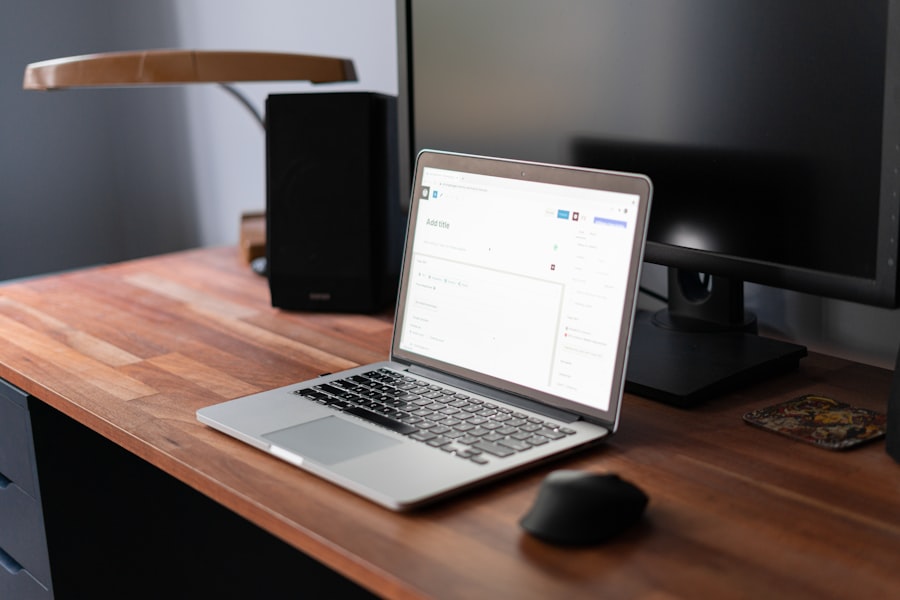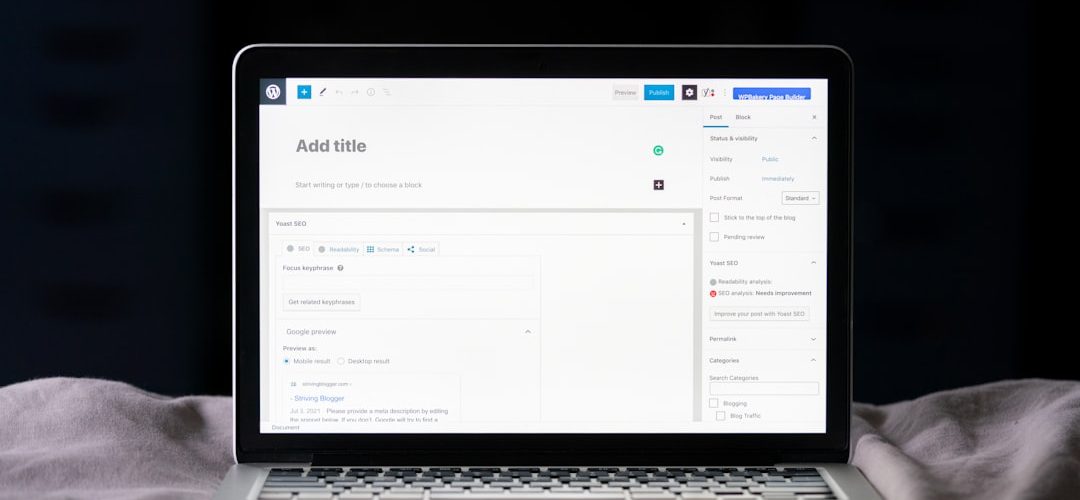When I first embarked on my blogging journey, I quickly realized the importance of setting clear goals. Without a defined purpose, it’s easy to lose direction and motivation. I began by identifying what I wanted to achieve with my blog.
Was it to share my passion for cooking, to build a community around a specific interest, or perhaps to establish myself as an authority in a particular niche? By articulating these goals, I was able to create a roadmap that guided my content creation and engagement strategies. Setting specific, measurable, achievable, relevant, and time-bound (SMART) goals has been particularly beneficial for me.
For instance, instead of vaguely stating that I wanted to increase my readership, I set a goal to gain 100 new subscribers within three months. This clarity not only motivated me but also allowed me to track my progress effectively. Each milestone I reached reinforced my commitment and provided a sense of accomplishment that fueled my passion for blogging.
Table of Contents
ToggleKey Takeaways
- Setting clear goals helps to focus your efforts and measure your success.
- Creating a consistent posting schedule keeps your audience engaged and coming back for more.
- Engaging with readers and followers builds a loyal community and encourages interaction.
- Networking with other bloggers can lead to collaborations and increased exposure.
- Staying updated on industry trends ensures that your content remains relevant and valuable.
Creating a Consistent Posting Schedule
Establishing a consistent posting schedule has been one of the most transformative practices in my blogging routine. Initially, I posted whenever inspiration struck, which led to erratic content delivery and fluctuating reader engagement. Realizing that consistency is key to building an audience, I decided to create a content calendar that outlined when and what I would post each week.
This structure not only helped me stay organized but also set expectations for my readers. By committing to a regular posting schedule, I found that my audience began to anticipate my content. This anticipation fostered a sense of community and loyalty among my readers.
I experimented with different frequencies—weekly, bi-weekly, and even daily posts—to see what resonated best with my audience. Ultimately, I discovered that quality trumps quantity; maintaining a balance between consistent posting and high-quality content has become my mantra.
Engaging with Readers and Followers

Engagement is the lifeblood of any successful blog, and I have made it a priority to connect with my readers and followers actively. Responding to comments on my blog posts and social media platforms has allowed me to foster relationships with my audience. I’ve learned that taking the time to acknowledge their thoughts and feedback not only makes them feel valued but also encourages them to return for more.
Moreover, I’ve found that asking questions at the end of my posts invites dialogue and interaction. By encouraging readers to share their opinions or experiences related to the topic, I create a two-way conversation that enriches the community aspect of my blog. Additionally, hosting giveaways or interactive polls has proven effective in boosting engagement and making my readers feel like they are part of something special.
Networking with Other Bloggers
| Metrics | Data |
|---|---|
| Number of bloggers in network | 50 |
| Frequency of communication | Weekly |
| Collaborative projects | 3 |
| Referral traffic from bloggers | 25% |
Networking with fellow bloggers has opened up a world of opportunities for collaboration and growth. Initially, I was hesitant to reach out to others in my niche, fearing competition rather than seeing the potential for partnership. However, once I began connecting with other bloggers through social media platforms and blogging communities, I realized the immense value in sharing experiences and resources.
Collaborative projects, such as guest posts or joint webinars, have not only expanded my reach but also enriched my content. By tapping into each other’s audiences, we create a win-win situation where both parties benefit from increased visibility. Additionally, these connections have provided me with invaluable insights into best practices and innovative strategies that have helped me refine my own blogging approach.
Staying Updated on Industry Trends
In the fast-paced world of blogging, staying updated on industry trends is crucial for maintaining relevance. I make it a habit to follow influential bloggers and industry leaders through newsletters, podcasts, and social media channels. This continuous learning process keeps me informed about emerging topics and shifts in audience preferences, allowing me to adapt my content accordingly.
Moreover, attending blogging conferences and workshops has been instrumental in expanding my knowledge base. These events not only provide valuable insights but also offer networking opportunities with like-minded individuals who share similar passions. By immersing myself in the latest trends and discussions within the blogging community, I can ensure that my content remains fresh and engaging for my audience.
Utilizing SEO Strategies

Search engine optimization (SEO) has become an essential component of my blogging strategy. Initially, I underestimated its importance, believing that great content alone would attract readers. However, as I delved deeper into the world of SEO, I realized that optimizing my posts for search engines significantly increased my visibility online.
I began by researching relevant keywords related to my niche and incorporating them naturally into my content. Additionally, optimizing meta descriptions and using alt tags for images has improved my blog’s searchability. By understanding how search engines rank content, I’ve been able to tailor my writing to meet both reader needs and algorithmic preferences.
This dual focus has resulted in increased organic traffic and a broader audience reach.
Experimenting with Different Content Formats
To keep my blog dynamic and engaging, I’ve embraced the idea of experimenting with different content formats. While written articles have always been my primary focus, I’ve discovered the power of diversifying my offerings through videos, infographics, podcasts, and even live streams. Each format presents unique opportunities for storytelling and audience engagement.
For instance, creating video tutorials related to my niche has allowed me to connect with visual learners who prefer consuming content in that format. Similarly, infographics have proven effective in distilling complex information into easily digestible visuals. By diversifying my content formats, I not only cater to different audience preferences but also keep myself creatively stimulated as a blogger.
Analyzing and Adapting to Analytics
Data analysis has become an integral part of my blogging strategy. By regularly reviewing analytics from platforms like Google Analytics and social media insights, I gain valuable insights into reader behavior and preferences. Understanding which posts resonate most with my audience allows me to tailor future content accordingly.
I’ve learned to pay attention to metrics such as page views, bounce rates, and engagement levels.
This data-driven approach enables me to identify trends and patterns that inform my content strategy.
For example, if I notice that certain topics consistently attract more traffic or engagement, I can prioritize similar themes in future posts.
Adapting based on analytics has empowered me to create content that truly resonates with my audience.
Balancing Creativity and Productivity
Finding the right balance between creativity and productivity has been one of the most challenging aspects of blogging for me. There are days when inspiration flows effortlessly, while other times it feels like pulling teeth to generate new ideas. To navigate this ebb and flow, I’ve developed strategies that allow me to maintain productivity without stifling creativity.
One approach that has worked well for me is setting aside dedicated time for brainstorming sessions. During these sessions, I allow myself to explore ideas freely without judgment or pressure to produce polished content immediately. This practice not only sparks creativity but also helps me build a reservoir of ideas that I can draw from when it’s time to write.
Additionally, establishing boundaries around work hours ensures that I remain productive while still allowing space for creative exploration.
Practicing Self-Care and Avoiding Burnout
As passionate as I am about blogging, I’ve learned the hard way that neglecting self-care can lead to burnout. The pressure to consistently produce high-quality content can be overwhelming at times, leading me to push myself beyond reasonable limits. Recognizing the signs of burnout early on has become crucial in maintaining both my mental health and the quality of my work.
I’ve implemented self-care practices such as setting aside time for hobbies outside of blogging, taking regular breaks during work sessions, and prioritizing physical activity. These practices not only recharge my energy but also provide fresh perspectives when I return to writing. By prioritizing self-care, I’ve found that I can approach blogging with renewed enthusiasm rather than viewing it as a chore.
Seeking Continuous Learning and Improvement
The journey of blogging is one of continuous learning and improvement. As someone who is deeply committed to personal growth, I actively seek out opportunities for skill enhancement through online courses, webinars, and reading industry-related books. This commitment to learning not only enriches my knowledge but also enhances the quality of the content I produce.
I’ve discovered that staying curious about new trends and techniques keeps me engaged in the blogging process. Whether it’s learning about advanced SEO strategies or exploring new social media platforms for promotion, each new piece of knowledge equips me with tools to elevate my blog further. Embracing a mindset of continuous improvement ensures that I remain adaptable in an ever-evolving digital landscape.
In conclusion, the journey of blogging is multifaceted and requires dedication across various aspects—from setting clear goals to practicing self-care.
By implementing these strategies into my routine, I’ve cultivated a thriving blog that resonates with readers while allowing me to grow both personally and professionally. As I continue on this path, I’m excited about the endless possibilities for creativity and connection within the blogging community.
In exploring the daily habits of highly successful WordPress bloggers, it’s essential to consider the tools and communities that support their productivity and creativity. One such resource is the Oxygen Builder, a powerful tool for designing WordPress websites. For those interested in leveraging this tool, the article “Empowering the Oxygen Builder Community” provides valuable insights into how bloggers and developers can enhance their website design capabilities. This article delves into the benefits of joining a community that shares tips, tricks, and support for maximizing the potential of the Oxygen Builder, making it a must-read for any WordPress blogger looking to elevate their site design.
FAQs
What are the daily habits of highly successful WordPress bloggers?
Highly successful WordPress bloggers have a set of daily habits that contribute to their success, such as creating high-quality content, engaging with their audience, and staying updated with the latest trends in the industry.
How do successful WordPress bloggers manage their time?
Successful WordPress bloggers manage their time effectively by creating a schedule for their tasks, prioritizing important activities, and using productivity tools to stay organized.
What role does content creation play in the daily habits of successful WordPress bloggers?
Content creation is a crucial part of the daily habits of successful WordPress bloggers. They consistently create high-quality, valuable content for their audience, which helps to attract and retain readers.
How do successful WordPress bloggers engage with their audience on a daily basis?
Successful WordPress bloggers engage with their audience by responding to comments, emails, and social media messages, as well as asking for feedback and creating interactive content to encourage participation.
What strategies do successful WordPress bloggers use to stay updated with industry trends?
Successful WordPress bloggers stay updated with industry trends by reading industry news, following influential bloggers and thought leaders, attending relevant events and conferences, and networking with other professionals in the field.
How do successful WordPress bloggers prioritize self-care and well-being in their daily routines?
Successful WordPress bloggers prioritize self-care and well-being by taking regular breaks, practicing mindfulness or meditation, exercising, and maintaining a healthy work-life balance to avoid burnout.




